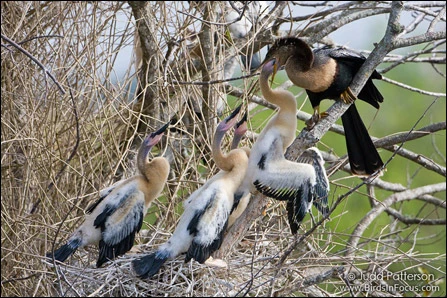
Photo courtesy of Judd Patterson, www.juddpatterson.com Anhingas (Anhinga anhinga) are one of the most iconic, and most photographed, bird species that inhabit Everglades National Park. 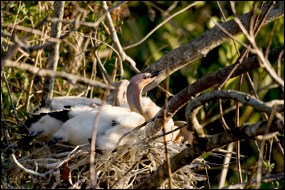
NPS photo by Rodney Cammauf Adult anhingas are large, dark waterbirds with a long, thin neck, a long, thin, pointed bill, a long tail, and silver patches on the wings. Males have greenish-black plumage overall, accentuated by silver-gray feathers on the upper back and wings that are edged with long white plumes. Females are brown with a lighter brown head and neck. Immature anhingas are more similar in coloring to adult females than to males. The anhinga is also known as the snakebird because it swims with its body submerged while stretching its head and neck out above the surface of the water, giving it the appearance of a snake about to strike while it glides through the water. Anhingas are also graceful fliers and can travel long distances without flapping their wings. 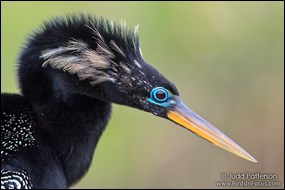
Photo courtesy of Judd Patterson, www.juddpatterson.com Anhingas are in the darter family, Anhingidae. Like other darters, anhingas hunt by spearing fishes and other small prey with their sharp, slender beaks. Because anhingas' feathers have an unique shape, their feathers become waterlogged when submerged in water, making it difficult for them to stay afloat. However, their waterlogged feathers allow them to dive easily and search for underwater prey, such as fish and amphibians. Anhingas can stay underwater for substantial periods of time. 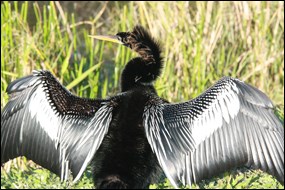
NPS photo by Leslie Velarde Anhingas often are seen perched with their wings spread, displaying their spectacular plumage. Whether wet or dry and especially in bright sunshine and cool temperatures, anhingas spread their wings, characteristically orienting themselves with their backs to the sun. Anhingas have unusually low metabolic rates and unusually high rates of body-heat loss. The spread-wing posture allows them to absorb solar energy to supplement their low metabolic heat production and to offset their high rate of heat loss. Anhingas lack the insulating layer of feathers sported by double-crested cormorants (Phalacrocorax auritus), which are sometimes confused with anhingas because of their similar appearance. Coupled with their low metabolism, the anhinga's lack of insulating feathers limits the northernmost extent of their range to the southeastern United States. While anhingas range widely to the south to take advantage of the warmer temperatures offered by South America, double-crested cormorants range to the colder climates of the north, all the way to Alaska. 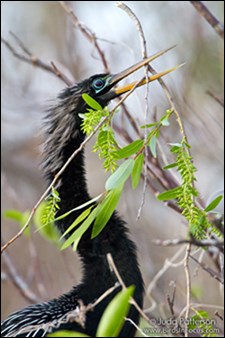
Photo courtesy of Judd Patterson, www.juddpatterson.com The Everglades are ideal habitat for anhingas, as they prefer shallow, slow-moving, sheltered waters for hunting with access to nearby perches and banks for drying and sunning themselves. Except during periods of severe drought, anhingas are rarely found out of freshwater habitat. Although anhingas are not generally found in extensive areas of open water, they may nest along the edges of open bays and lakes. They typically breed in freshwater colonies, often in association with other waterbirds such as herons, egrets, ibises, storks, and cormorants. Anhingas also may breed in saltwater colonies and feed in areas of freshwater. Male anhingas gather the nesting material, and females construct the nest by weaving sticks together and padding it with live twigs and green leaves. Anhingas are monogamous and pairs may reuse the same nest from year to year. 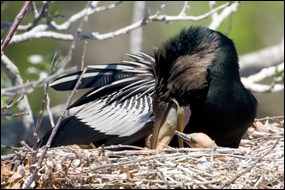
NPS photo by Rodney Cammauf Female anhingas typically lay from two to six pale bluish-green eggs. The parents share incubation of the eggs for 25 to 30 days. Upon hatching, anhinga chicks are naked and helpless. They eventually grow a white down on their belly and a dark down on their back . At first the parents feed the chicks by dripping fluid and regurgitated material from partially digested fish down their throats. As the chicks grow older, they shove their heads into their parents' beaks to reach their food. The chicks reside in the nest for about 3 weeks but if threatened, they are able to drop into the water and swim away, later climbing out of the water and back into the nest. At about 3 weeks of age they are able to climb out of the nest and onto a branch, and they fledge at about 6 weeks of age. They stay with their parents for several more weeks before becoming independent. Anhingas are believed to reach sexual maturity at about 2 years of age. Listen to the raspy, croaking call of an anhinga below. The requested video is no longer available.
|
Last updated: June 6, 2018
